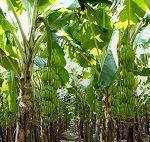Introduction
Plantain is one of Nigeria’s most widely consumed and commercially valuable food crops. It’s not just a household staple but also a crucial source of income for millions of farmers and traders across the country. Its versatility—boiled, fried, roasted, or processed into chips—makes it a favorite in Nigerian kitchens. But beyond consumption lies an economic goldmine that remains underutilized. Understanding where, how, and when plantain is produced in Nigeria can unlock major opportunities, both for local consumption and international trade.
Where Plantain is Produced in Nigeria
Plantain thrives in Nigeria’s humid, tropical zones. It grows best in areas with consistent rainfall and well-drained loamy soil. As such, the southern and central regions of the country dominate production.
The top producing states include:
- Ondo
- Edo
- Delta
- Bayelsa
- Cross River
- Akwa Ibom
- Rivers
- Abia
- Enugu
- Osun
- Ekiti
These states have the right climatic conditions—typically over 1,500mm of annual rainfall and temperatures between 25–30°C. They also benefit from forest vegetation, which helps improve soil fertility and reduce erosion, supporting the healthy growth of plantain plants.
Some parts of Kogi, Benue, and Nasarawa in North Central Nigeria are also involved in commercial-scale plantain farming due to the rising demand in Northern markets.
How Plantain is Produced
Plantain farming in Nigeria is largely traditional and labor-intensive. However, despite the minimal mechanization, the process remains structured.
1. Land Preparation
Farmers begin by clearing land manually or using simple tools. In some areas, tractors are used, especially for commercial farms. The land is usually cleared during the dry season in preparation for planting when the rains begin.
2. Sucker Selection and Planting
Plantain is propagated through suckers—shoots taken from mature plantain plants. Farmers typically choose sword suckers, which have narrow, pointed leaves and are more vigorous. Suckers are planted about 3–4 feet apart in rows to allow easy movement and sunlight penetration.
3. Fertilization and Mulching
Though plantain grows well in fertile soil, organic manure or compost is often applied to boost productivity. Mulching is also practiced to conserve soil moisture and suppress weeds.
4. Maintenance and Pest Control
Regular weeding, pruning, and pest control are essential. Farmers battle pests like banana weevils and diseases such as black sigatoka, which can reduce yields significantly. In commercial setups, integrated pest management practices are used.
5. Harvesting
Plantain matures between 8–12 months after planting. Harvesting is done manually using machetes or harvesting knives. Bunches are cut before the fingers fully ripen to avoid spoilage and ease of transport.
Quantity of Plantain Produced in Nigeria
Nigeria ranks among the largest plantain-producing countries in the world, only behind Ghana and Cameroon in Africa. According to data from the Food and Agriculture Organization (FAO) and the National Bureau of Statistics (NBS), Nigeria produces over 2.8 million metric tonnes of plantain annually.
However, this figure fluctuates due to issues such as poor storage infrastructure, post-harvest losses, and climate variability. Up to 30–40% of harvested plantain is lost between the farm and market, especially during peak seasons when supply exceeds demand.
If properly harnessed, Nigeria’s production could cross the 4 million metric tonnes mark, making it a global leader in both raw and processed plantain exports.
Highest Producing States by Quantity
Although many states grow plantain, a few lead in output due to farm size, climate, and market linkages. These include:
- Ondo State – Often called Nigeria’s plantain capital. It boasts massive plantations and has become a sourcing hub for plantain processing companies.
- Edo State – Leverages its fertile forest zones to produce year-round.
- Delta State – Combines traditional farming with growing commercial investments.
- Cross River State – Benefits from high rainfall and a growing agro-processing industry.
- Akwa Ibom and Rivers – Strong local demand and proximity to ports give them a trade edge.
Each of these states contributes over 200,000 metric tonnes annually, with some like Ondo pushing towards 400,000 metric tonnes, especially in favorable years.
Trade Numbers and Market Activity
Despite Nigeria’s huge production, plantain exports remain minimal. Most of the yield is consumed locally. However, the tide is changing. Demand for Nigerian plantain, especially in dried or chip form, is growing in:
- Europe (UK, Netherlands)
- North America (US and Canada)
- Middle East (UAE, Saudi Arabia)
In 2023, Nigeria’s official dried and processed plantain export figures were estimated at less than $1.5 million, a figure that could grow exponentially with the right infrastructure and trade policies.
Locally, the market is worth billions of naira. According to market reports, the plantain value chain—covering farming, processing, and retail—is valued at over ₦500 billion annually. With the rise in snack companies, food vendors, and supermarkets, plantain chips and flour have become everyday products.
Investors are tapping into this value chain, setting up mini-processing plants to produce flour (used as a gluten-free alternative) and crisps (plantain chips), which are gaining popularity across Nigerian cities and African diaspora communities.
Seasonality: When Plantain is Available
Plantain is available year-round in Nigeria, but its supply is not uniform throughout the year. Like most crops, it is influenced by the rain and dry seasons.
Peak Production Months:
- June to September
This period marks the highest supply as most plantains mature during or after the rainy season.
Lean Production Months:
- December to March
These months represent the off-season or dry spell. Supply drops, and prices rise significantly. Farmers often rely on irrigation or swampy areas to keep production ongoing, but the volume remains low.
Understanding this cycle is crucial for anyone in the plantain business—whether in farming, processing, or distribution. Planning around the peak and lean months allows stakeholders to manage inventory, price fluctuations, and market strategy better.
Conclusion: Tapping Into the Green Gold
Nigeria’s plantain sector is ripe with opportunities. From farm to fork, every stage of the value chain can create wealth and jobs. However, for Nigeria to truly benefit from its massive production potential, certain actions are critical:
- Improving storage and transportation to reduce post-harvest losses.
- Encouraging commercial farming and mechanization.
- Establishing quality standards for exportable products like chips and flour.
- Training farmers and processors in best practices and trade compliance.
- Creating linkages with international buyers through trade fairs and digital platforms.
If stakeholders—from government bodies to agropreneurs—focus on building a strong, well-structured plantain ecosystem, Nigeria can lead the continent not just in production, but also in exports and innovation in the plantain value chain.
You can contact us on WhatsApp to discuss this topic further.




